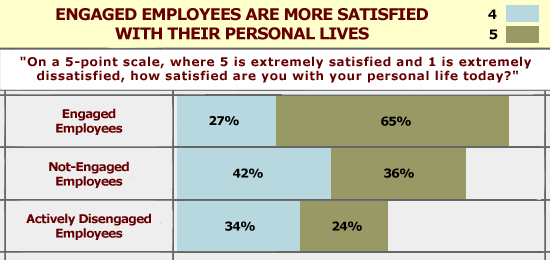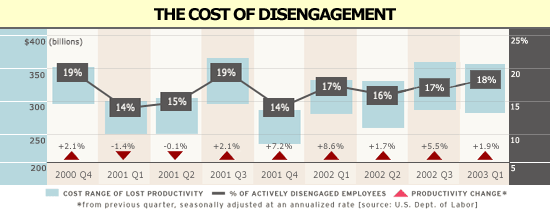Thanks to major social and technological changes, it’s now tougher than ever for employees to leave their work problems at the door when they head home, and vice versa. New data from Gallup’s Employee Engagement Index offer insight into the degree to which engagement levels at work may affect employees’ attitudes and behavior away from the office.
For many employees, it’s become almost impossible to maintain strict boundaries between their personal and professional lives. Cell phones and PDAs ensure that bosses can reach employees even on the beach. And while high-speed networks allow millions of workers to avoid traffic gridlock by telecommuting, this technology has transformed homes into workplaces. Daunting questions, dear telecommuter: When, exactly, does your workday begin? And when does it end?
The collapse of the dot-com bubble and the onset of recession have also caused families to blur their work and personal lives. And family working arrangements have become more varied. A recent review of Gallup Poll data from the last two years finds that in 63% of households studied, both partners bring home a paycheck, and in about one-fifth of those households, the wife earns more than the husband (18%) (see "Husbands Bring Home Most of the Bacon" in See Also). In some instances, less traditional family arrangements can create stress, as there is still considerable social pressure on males to be the primary wage earners. So couples under financial pressure are constantly evaluating which home/work arrangement will be best for all family members.
Given this rapid change, it seems particularly important to understand how employees’ professional lives can affect their relationships with family members and friends and their assessment of the quality of their lives overall. One factor that may be underplayed in the home/work equation is the quality of the workplace itself.
The conditions of their lives
One reason the effects of employee satisfaction have been tricky to assess is that it’s tough to find a measurement that works across a variety of industries and types of workplaces. Gallup’s Q12 -- a 12-question survey that measures employee engagement across 12 key workplace dimensions -- removes that obstacle, having been validated across 10,885 workgroups in 23 industries.
The Employee Engagement Index survey conducted for the Gallup Management Journal found compelling differences between employees who are engaged with their jobs (those who identify with their work and actively promote company objectives) and employees who aren’t, in their responses to questions about their personal lives and their lives in general.
For the most part, Americans rate satisfaction with their personal lives highly: 78% score their satisfaction at 4 or 5 on a 5-point scale. But engaged workers are much more likely to respond with 5s (65%) than 4s (27%). "Not-engaged" workers (those who aren't engaged with their work but aren't actively disenchanted) are less likely to respond with 5s (36%) than 4s (42%). We see the same pattern when workers are asked to rate their level of agreement with the statements: "I have gotten the important things I want in my life" and "The conditions of my life are excellent."
 |
It’s tough to find underlying connections here. In some cases, workers who have negative relationships at work -- such as with their managers or coworkers -- also may tend to have unsatisfying personal relationships simply because they are bad at relationships. But considering the two survey statements above, it seems reasonable that a lack of connection with work is dampening respondents’ enthusiasm for the broader conditions and progress of their lives. In any event, employees who are not engaged in their roles are more likely to register discontent with their lives in general and their personal lives in particular.
Behaving poorly
Employees were also asked if there were three or more days in the past month when the stress of work caused them to "behave poorly" with their families or friends. Here, the big difference occurs between "actively disengaged" workers (those who are profoundly disconnected from their work) and everyone else. In fact, it’s alarming that just over half of those who are actively disengaged -- 51% -- respond affirmatively to this question. That figure drops to 29% among those who are not engaged and further to 18% among engaged employees.
 |
What about the other way around -- that is, do these data indicate that different family conditions make employees less likely to be engaged at work? Not really. Single and married people, those with and without children, households with one wage earner versus two or more -- all have similar proportions of engaged, not engaged, and actively disengaged workers. Divorced people are slightly more likely to be actively disengaged. But given the number of disengaged employees who say that work caused them to behave badly with family and friends, it’s possible that work conditions may have influenced respondents’ marital status, rather than the other way around.
The finding that home-life circumstances make little difference in engagement scores is no surprise, given that Gallup’s engagement measure is highly focused on workplace conditions. But it is useful for managers to know that workers’ perceptions of those conditions aren’t significantly colored by factors the managers can’t influence.
Conclusion
Traditional family roles may be in flux, but unfortunately some statistics aren’t changing as rapidly. The U.S. divorce rate seems stubbornly fixed at around 40%. What’s more, family violence continues to cost the nation billions of dollars annually in medical expenses, shelters and foster care, police and court costs, sick leave, absenteeism, and lost productivity. The employee engagement figures presented here suggest that, for better or worse, working conditions relate to employees’ home lives. Given that the personal and professional arenas are becoming harder to separate, recognizing and understanding the emotional links between the two -- and determining how workplace conditions can best promote harmony between them -- can potentially improve employees’ lives at work and at home.
 |
|
Results of this survey are based on a nationally representative sample of about 1,000 employed adults aged 18 and older. Interviews conducted by telephone during October 2000 - March 2003 by The Gallup Organization. For results based on samples of this size, one can say with 95% confidence that the error attributable to sampling and other random effects could be plus or minus three percentage points. For findings based on subgroups, the sampling error would be greater. |